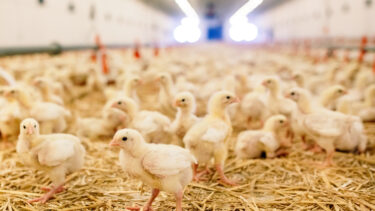Light management for chicks, a bright idea for success
Receive all our future audio articles in your mailbox
Lighting is an important management tool to optimally serve the development of your poultry flock and it can even steer certain developments like sexual maturation, general behavior, or stimulation of feed intake. Therefore, it is worth the time and attention to understand and provide an optimal lighting program for your poultry flock. Depending on your housing system, species, and type of production system, different approaches to lighting and light management are required. With the right equipment and requirements, the lighting of the poultry house can help achieve desired results in the flock itself.
PROPERTIES of light
Light is electromagnetic radiation, meaning it does not require a medium (e.g. air or water) to travel through and is measured in nanometers (nm). Most species have a specific bandwidth of radiation they can perceive and process depending on how they are physiologically and anatomically equipped.
Colors of light from ultraviolet to red

Depending on wavelength and amplitude, light characteristics are also measured by other parameters than only spectrum. For example, color temperature (CCT) is measured in Kelvin degrees and is affected by the length of the electromagnetic waves. The longer the electromagnetic waves, the lower the color temperature will be.
Color distirbution in degrees Kelvin

Sight perception of chickens
Poultry has a bandwidth of sight between approx. 350-780 nm, which is wider than a human’s bandwidth of 400-600 nm. This means poultry can perceive more electromagnetic radiation than humans. Due to a different set-up of the eye, the sensitivity for certain wavelengths differs as well. The eye perceives light through photoreceptors (cones and rods), the rods allow you to see shapes and movements and the cones perceive color. Chickens have an extra double cone that humans do not have. This double cone allows chickens to see indigo blue light and flickering better than humans.
Chicken vs. human color perception

Light Intensity
Flicker is caused by the difference between the minimum and maximum light intensity during one wavelength of that color spectrum, this difference is called the flicker percentage. With increasing brightness, the difference between minimum and maximum brightness increases and, consequently, the flicker percentage increases. Since flicker is caused by the number of light waves per second as is displayed in Hertz (Hz), the more light waves per second (think of the color blue vs. red), the shorter the light waves become. The higher the Hz is, the less likely it is to detect flicker.
Whether flicker is perceived can best be determined with the flicker index. The flicker index is the ratio between the number of Hz and the flicker percentage. A chicken will detect a flicker from a flicker index of 0.06.
Calculating flicker percentage

Practical tip:
Flickering stresses poultry immediately and worsens with increased light density. Therefore, it is important to use flickerless bulbs like LED.
Light management
After describing what light is, we now come to its purpose for poultry rearing. Light has several purposes for poultry. The first and most obvious is that a chicken must be able to find its food and water. In addition, a chicken must have sufficient light to move through the house without bumping into things. Light is also necessary for hormone production, as it influences various hormone levels and helps initiate the start of sexual development. It can also be used to trigger or reduce feed intake. Finally, with the help of light, the chickens can recognize the immediate environment and a number of congeners as acquaintances, which reduces stress.
Due to the importance of light, there are legal obligations and rules in several countries of the world. Besides these obligations, there are minimal requirements for the animals as well as scientific recommendations to efficiently use the effects of proper lighting.
Minimal requirements for chickens:
- Spectrum: The installation must emit a minimum of light over the spectrum of 400 to 650 nanometers (nm) and the distribution of nanometers should be gradual. Large peaks and troughs in the spectrum must be avoided. The more widely distributed and smoother the light transition the better it is for the animals.
- Flicker index: Poultry perceives flicker from a flicker index of 0.06. Make sure that the flicker index is less than 0.06, however, lower is better.
- The lighting must be dimmable from zero to the maximum possible lux (intensity) of the installation. Dimming the light enables control of animal behavior or stimulation.
Calculating flicker percentage

To fulfill the general requirements and legal obligations, it is common to use specific lighting programs for poultry. Readily available for each breed from the genetic supplier, successfully utilizing lighting stages early in life is important for steering the properties described above. In general, there is a differentiation in light management goals between meat and reproductive poultry species:
Meat Poultry:
Activate growth and activity to quickly reach high feed intake and good development
Reproductive Poultry:
After the early starter phase, control body development and sexual maturation
Therefore the lighting programs may divide for different breeds and purposes. Due to the heavy impact on the development of your flock, it is wise to follow the programs closely as possible. Following proper light management will ensure the birds achieve their full genetic potential and maximum performance.
This contact was suggested based on the location you are browsing from. You can of course also consult our other contacts and locations here.

